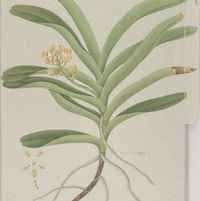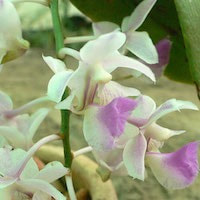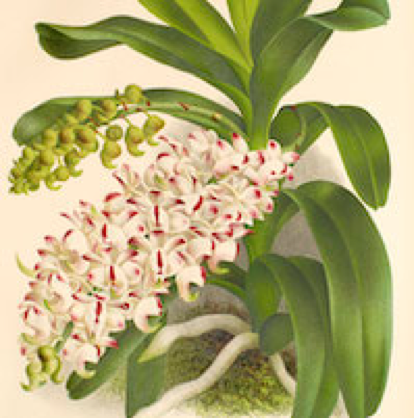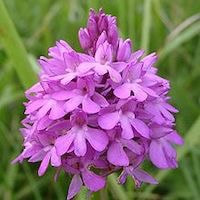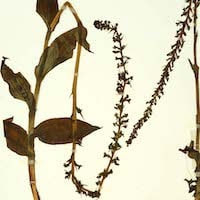WC3 - Women's Citrus 3 - Lime shower on a hot summer day
|
Native Singaporean Orchid notes: Rhynchostylis Gigantea
This type of orchid has a strong citrus smell. Rhynchostylis orchids are called foxtail orchids because their long, thin clusters of flowers are packed tightly together and smell sweet. These clusters usually appear in the fall and winter. In Singapore, these orchids bloom 1-3 times a year depending on the weather. The flowers have a strong smell and can last up to three weeks in Singapore's weather. Finding this orchid is hard because it has such a strong citrus scent, and it mostly blooms in January and February.
|
Therapeutic Orchid notes:
|
Acampe carinata (Griff.) Panigrahi
Acampe carinata, also known as 'rigid air flower', is a strong plant with stiff leaves and flowers. It grows in Thailand, Myanmar, Sikkim, Mumbai, the Western Ghats, and Sri Lanka. In Thailand, people use the whole plant as a tonic to make the body stronger. In Orissa, India, a paste from its roots treats snake and scorpion bites, while a paste from its leaves mixed with garlic helps chest and stomach pain. In Uttarakhand, in the Himalayas, it's used for rheumatism, sciatica, and nerve pain. Acampe carinata contains many chemicals that are good for health, like alkaloids, anthocyanins, and more. |
|
Aerides falcata Lindl.
Aerides falcata, also known as Zhijia Lan in Chinese and Ueang Kulaab Krapao Perd in Thai, has a delightful fragrance and many uses. This orchid produces clusters of white flowers, each cluster containing about 30 intensely fragrant flowers. It grows in places like Thailand, Indochina, and Myanmar, but not further south. In Vietnam, people use Aerides falcata to strengthen weak babies. Its seeds are also sprinkled on boils and other skin problems to help them heal. |
|
Aerides odorata Lour
Commonly known as Fragrant Aerides, this orchid species grows well in clusters when exposed to direct sunlight for half a day near water. It's often seen in Singapore and blooms from August to September with clusters of 20-30 highly fragrant flowers lasting about two weeks. In Nepal, the leaves of Fragrant Aerides are made into a paste for cuts and wounds. In India, the fruit heals wounds, while leaf juice treats ear and nose boils. Vietnamese use seeds for skin problems. In Orissa, hill tribes mix its root with other herbs for joint pain. Its extracts inhibit certain bacterial strains and contain antimicrobial aeridin. It also has gigantol, imbricatin, methoxycoelonin, and other compounds. |
|
Anacamptis pyramidalis
Like mentioned above, Salep is made from few types of Anacamptis. This is harvested in Turkey (and Iran) for use as salep . Best grades of salep should have a mucin content greater than 40 % and an ash content which is lower than 5 %. This orchid has mucin content of 44.72 % and an ash content of 1.72 %, which makes it one of the top 5 choices to make Salep. It produces two phytoalexins, orchinol and p-hydroxybenzyl alcohol and hence is used in skin whitening. It also exhibits antioxidant and scavenging capacities in vitro. |
|
Platanthera clavigera Lindl. syn. Habenaria densa Wall.
The plant called Jishencao, also known as chicken kidney grass, grows in Kashmir, Nepal, and Bhutan at high altitudes. It's harvested in August and September for medicine. People use the whole plant to help the kidneys and lower back work better. It's especially used for problems like impotence, hernia, and bedwetting in kids. Jishencao also gives strength to the lungs and kidneys |
Other scent note
Pineapple, Green, tayberry, Mandarin Orange, Papaya, Bergamot, Cardamom, Lemon, Hasaku, lemon verbana, star apple
Scentopia Library Reference ingredient
Download the guided mediation that works best with this Orchid fragrance oil
| women_citrus_essential_oil_orchi_00003.mp3 | |
| File Size: | 184820 kb |
| File Type: | mp3 |

